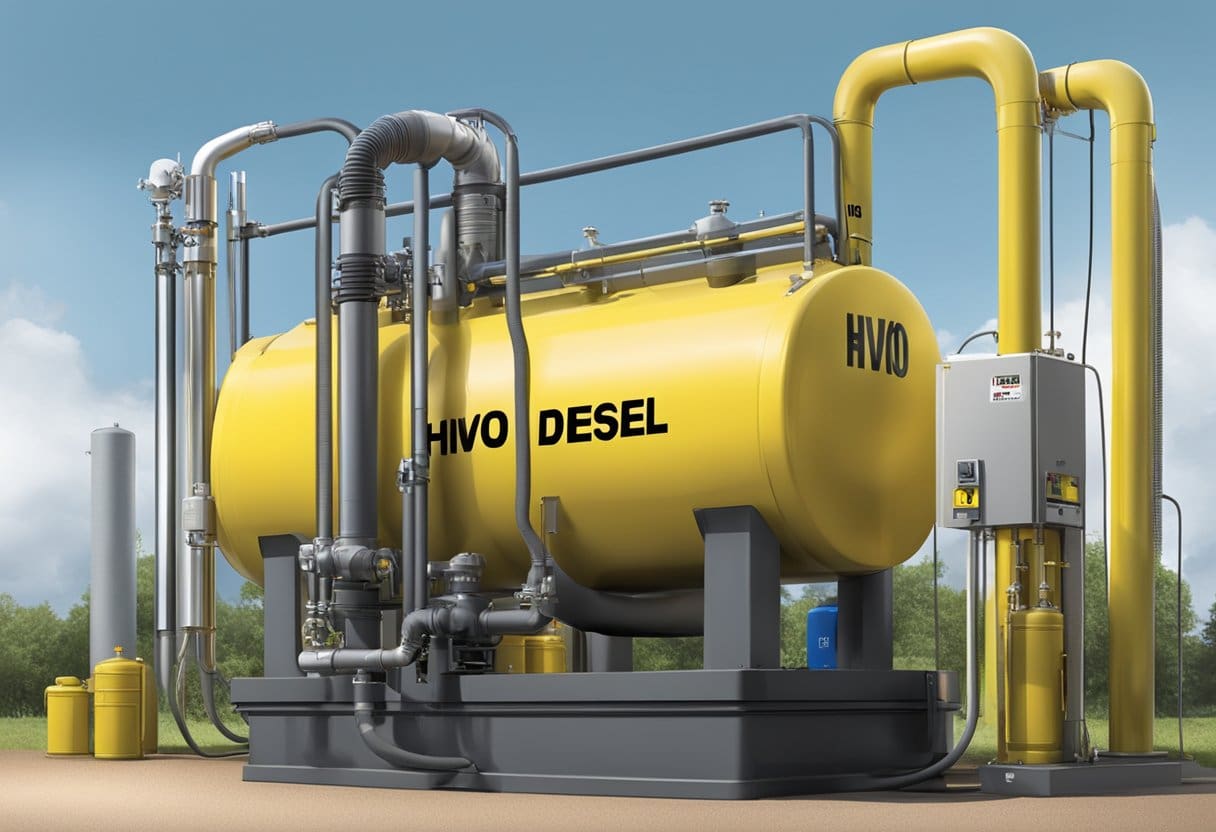How to store HVO fuel (Hydrotreated Vegetable Oil) is becoming a more pertinent question due to the emerging popularity of HVO being a viable alternative fuel for vehicle fleets including ambulances, police vehicles, and fire services. Utilised by local governments and organisations attentive to their environmental footprint, HVO fuel offers a reduced CO2 emissions profile compared to traditional diesel. The longevity and efficacy of this fuel are significantly influenced by proper storage solutions. Ensuring the correct handling and storage of HVO fuel is not only pivotal for maintaining its environmental benefits but also for ensuring the smooth operation of critical services that rely on these fuels.

Storing HVO fuel effectively guards against degradation and preserves its quality over time. Given its capacity to be stored for extended periods, HVO fuel does not require the frequent turnover associated with conventional diesel, making it a strategic choice for long-term operational planning. Adequate storage systems protect HVO fuel’s integrity, safeguarding against external factors such as moisture and temperature fluctuations, which are particularly relevant in the British climate. By prioritizing appropriate storage solutions, entities like local governments and fleet managers can leverage the advantages of HVO fuel, nurturing a more sustainable and resilient fleet operation.
How to store HVO Fuel: Key Takeaways
- Correct HVO fuel storage ensures fuel integrity and prolongs shelf life.
- HVO fuel is a sustainable choice for essential services like emergency vehicles.
- Effective storage practices are crucial for the benefits HVO fuel offers.
How to store HVO Fuel: Understanding HVO Fuel

Hydrotreated Vegetable Oil (HVO) fuel represents a significant advancement in renewable fuels. Comprised of fats or oils, it stands out due to its chemical structure and storage benefits, particularly for essential services like ambulances, police vehicles, fire vehicles, local government, and varied vehicle fleets.
How to store HVO Fuel: Hydrotreated Vegetable Oil Origins
HVO fuel stems from the process of hydrogenation wherein vegetable oils or animal fats are treated with hydrogen at high temperatures. This process strips away oxygen and improves the fuel’s stability and performance characteristics. Notably utilised by emergency services, the production of HVO fuel provides a cleaner alternative fuel suitable for a broad array of vehicles.
How to store HVO Fuel: Comparison with Conventional Diesel
In contrast to conventional diesel fuel, HVO fuel holds an isomer structure similar to fossil diesel which contributes to its superior storage life. This fuel variant does not require significant modifications to existing diesel engines, making it an attractive option for vehicle fleets aiming to reduce their carbon footprint without extensive equipment changes.
How to store HVO Fuel: Benefits of HVO Fuel
Advantages of HVO fuel include:
- Reduced Emissions: HVO fuel combustion emits less CO2 and particulates, contributing to cleaner air quality.
- Enhanced Storage: It possesses a longer storage life than traditional diesel, reducing waste and maintenance requirements for HVO fuel storage.
- Extreme Weather Resistance: HVO fuel can withstand lower temperatures, essential for reliable operation in emergency vehicles such as ambulances, police, and fire services during cold weather.
The unique composition of HVO fuel demands specific storage solutions, thereby ensuring its purity and efficacy for critical services like local government and emergency fleets are maintained.
How to store HVO Fuel: Storage Fundamentals

When considering “How do I Store HVO Fuel,” understanding and establishing the basic principles of storage are critical. This section covers the ideal conditions, safety measures, and contamination prevention required for efficient HVO fuel storage.
How to store HVO Fuel: Creating the Ideal Storage Environment
For optimal HVO fuel storage, it is essential to maintain a stable temperature and protect the fuel from extreme weather. HVO fuel, used by ambulance services, police vehicles, fire vehicles, and local government vehicle fleets, requires a storage environment that can prevent the fuel from freezing at temperatures below -30°C.
- Temperature: Keep storage tanks insulated or in temperature-controlled areas to maintain fuel efficacy.
- Accessibility: Ensure that tanks are easily accessible for monitoring and refuelling.
- Ventilation: Proper ventilation reduces the risk of condensation—addressing a critical aspect of HVO Diesel Storage for large vehicle fleets.
How to store HVO Fuel: Safety Measures for HVO Fuel Storage
Storing HVO fuel safely is paramount, especially for key services like ambulance, police, fire services, and local government authorities that depend on their vehicle fleets’ readiness.
- Spill Containment: Implement spill containment measures to prevent soil and water contamination.
- Fire Safety: Use fire-rated tanks and equipment, and maintain clear signage and access to fire extinguishers.
- Regular Maintenance: Schedule periodic inspections and maintenance of storage tanks to ensure safety and integrity.
How to store HVO Fuel: Preventing Contamination
Contamination can significantly degrade HVO fuel’s quality and performance, particularly for emergency vehicle fleets such as ambulances and fire trucks.
- Sealed Containers: Use tanks with secure, sealed lids.
- Clean Transfer Equipment: Maintain cleanliness of pumps, hoses, and nozzles.
- Monitoring Systems: Install quality monitoring systems to detect water, microbial growth, or particulates.
By focusing on these storage fundamentals, entities such as local government and operators of extensive vehicle fleets can ensure reliable and efficient use of HVO fuel.
How to store HVO Fuel: Operational Guidelines

When embarking on how to store HVO fuel, understanding the correct protocols for handling and usage, as well as ensuring compatibility with vehicle engines, is crucial to maintain safety and efficiency, particularly for critical service fleets such as ambulances, police, and fire vehicles, as well as local government and other vehicle fleets.
How to store HVO Fuel: Handling and Usage
Proper handling of HVO fuel involves stringent practices to safeguard storage integrity and personnel safety. Transporting HVO fuel should be done using appropriate containers designed for flammable liquids, labelled clearly for identification, and placed on vehicles with care to prevent spills. It is also essential to:
- Use dedicated pumps and hoses for HVO fuel to avoid cross-contamination.
- Perform routine checks on storage tanks for leaks, corrosion, or damage.
- Implement spill control measures including drip trays and spill kits.
Important: Whilst transferring HVO fuel, one must ensure to ground the storage tank to avert static electricity buildup, a potential ignition source.
The operational guideline for HVO fuel storage in the context of vehicle fleets, including ambulances, police vehicles, and fire engines, is to store at ambient temperatures in a well-ventilated area, away from direct sunlight. This helps in maintaining fuel stability and prolongs storage life.
How to store HVO Fuel: Engine Compatibility and Adjustments
HVO fuel boasts wide compatibility with most diesel engines, making it a viable alternative fuel option for numerous vehicles. However, it’s imperative to:
- Consult the engine manufacturer or a professional mechanic to confirm HVO fuel compatibility with specific engine models.
- Check for any engine adjustments necessary to optimise HVO fuel use, which may include fuel filter changes or engine tuning.
Local government and emergency service providers have been transitioning to HVO fuel storage to bolster their sustainability efforts without compromising vehicle performance. For instance, fleets of ambulances and fire vehicles have reported seamless HVO fuel integration, with no major engine modifications needed, reducing their carbon footprint effectively.
Maintaining a regular maintenance schedule is crucial, especially after switching to HVO fuel, to monitor any changes in engine performance and fuel efficiency. This proactive approach ensures that fleets are always ready for duty and perform optimally.
How to store HVO Fuel: Strategic Integration

Successfully incorporating HVO Fuel into your operations hinges on thoughtful integration into existing infrastructures and preparing for future fuel needs. This section delves into the practical steps for HVO fuel storage and use, with a focus on specialised vehicles and the needs of the local government.
How to store HVO Fuel: Incorporating HVO into Existing Infrastructures
Integrating HVO Fuel into current operations requires minimal adjustments, making it an efficient alternative for vehicle fleets. Ambulances, police vehicles, and fire vehicles have successfully transitioned to HVO, often cited for its storage versatility and extended shelf life. Local governments find HVO fuel storage particularly advantageous, ensuring emergency services run smoothly with reduced carbon emissions. Storage stability is a key consideration; HVO’s long shelf-life of up to 10 years ensures reliability over time, negating worries about regular fuel turnover.
How to store HVO Fuel: Future-Proofing with HVO
Local Government bodies and companies managing vehicle fleets should not only think about current fuel needs but also anticipate changes in environmental regulations. Transitioning to HVO fuel positions fleets from ambulances to police and fire vehicles as forward-thinking and compliant with tightening emissions standards. By incorporating HVO fuel, they demonstrate an investment in a more sustainable operation capable of adapting to future energy landscapes. In 2024 London Gatwick switched it’s ground fleet to run on HVO, saving them more than 950 tonnes of carbon emissions per annum.
How to store HVO Fuel: Advantages and Challenges

When considering the transition to HVO fuel for public service vehicle fleets, such as those used by local government, ambulances, police, and fire services, it’s important to evaluate both the benefits and challenges. The adoption of HVO fuel can influence operational performance and environmental impact significantly.
How to store HVO Fuel: Environmental and Operational Benefits
Hydrotreated Vegetable Oil (HVO) fuel is lauded for its lower carbon emissions compared to traditional diesel, making it a compelling choice for vehicle fleets mindful of their environmental footprint. HVO fuel’s renewable origins contribute to its sustainability, thus aligning with local government mandates for cleaner energy. Moreover, HVO fuel storage does not require significant alterations to existing infrastructure, as it is a drop-in fuel compatible with current diesel engines used in ambulances, police vehicles, and fire vehicles. Its chemical stability and ability to operate in a broad range of temperatures enhance the operational efficiency of fleets.
- Reduced Emissions: Ideal for organisations aiming to achieve net-zero targets.
- Higher Cetane Number: Leads to improved combustion and engine performance.
- Storage Stability: Easier to handle, with a longer shelf life than other biodiesels.
How to store HVO Fuel: Overcoming HVO’s Adoption Challenges
While the benefits of HVO fuel are clear, adoption challenges remain. Initial costs may be higher, and widespread availability is still growing, which can be a concern for extensive networks like those maintained by local governments and emergency services. Engaging with reputable suppliers and considering long-term environmental goals can help to mitigate these issues. Strategies to increase the use of HVO fuel within vehicle fleets should focus on educating stakeholders about the long-term operational savings and ecological advantages, offsetting apprehensions around early adoption.
- Educational Outreach: Informing fleet managers and the public about HVO’s advantages.
- Cost Analysis: Demonstrating the potential for longer-term cost savings and sustainability benefits.
- Supply Chain Development: Collaborating with suppliers to ensure reliable access to HVO fuel.
For organisations considering how to store HVO fuel, it’s essential to recognise that its storage aligns closely with standard diesel, offering a favourable transition for public service entities with extensive vehicle fleets.
How to store HVO Fuel: Frequently Asked Questions

In addressing common queries regarding HVO fuel storage, it’s important to consider the specific needs and regulations applying to key service vehicles such as those used by the ambulance, police, and fire services, as well as by local government and vehicle fleets.
What precautions should be taken when storing HVO fuel to maintain its quality?
To maintain the quality of HVO fuel during storage, it is essential that it is kept in a cool and dry place away from direct sunlight. Regular checks for contamination should also be a part of the storage maintenance protocol.
Can HVO fuel be stored in the same tanks as traditional diesel fuels, and if so, are there any special requirements?
HVO fuel can be stored in the same tanks as traditional diesel without the need for costly infrastructure changes. However, the tank and the fuel system should be completely free from any residues of conventional diesel to fully capitalise on HVO’s benefits.
What is the maximum storage duration for HVO fuel before it starts degrading?
HVO fuel offers a superior shelf life compared to conventional diesel, remaining stable and usable for up to 10 years under optimal storage conditions.
Are there any specific temperature conditions to consider for the storage of HVO fuel?
HVO fuel can withstand colder temperatures, not freezing until below approximately -30°C. This makes it well-suited for storage in varying climatic conditions without the worry of the fuel thickening or gelling as quickly as regular diesel.
How does the storage of HVO fuel differ from the storage of standard diesel fuels?
In comparison to standard diesel, HVO fuel storage does not require any unique equipment or infrastructure. However, its stability and less stringent temperature storage requirements provide more flexibility and potential for longer storage duration.
What measures should be implemented to ensure the safety and environmental compliance of HVO fuel storage?
Safety measures for HVO fuel storage include proper labelling, secure containment to prevent spills, and adherence to local environmental regulations. Additionally, monitoring for leaks and having spill response equipment readily available is crucial for maintaining safety and compliance.





